The Ukraine crisis exposes a flaw in President Biden’s Iran strategy. Washington engages with Beijing and Moscow as if they share core U.S. interests with respect to Iran, when instead they are working with Tehran to undermine the American-led global order.
That’s certainly what officials in Tehran are saying. Last Wednesday, Mahmoud Abbaszadeh-Meshkini, a spokesman for the Iranian Parliament’s National Security and Foreign Policy Committee, said: “In the new world order, a triangle consisting of three powers—Iran, Russia, and China—has formed.” He was clear about the goal: “This new arrangement heralds the end of the inequitable hegemony of the United States and the West.”




















